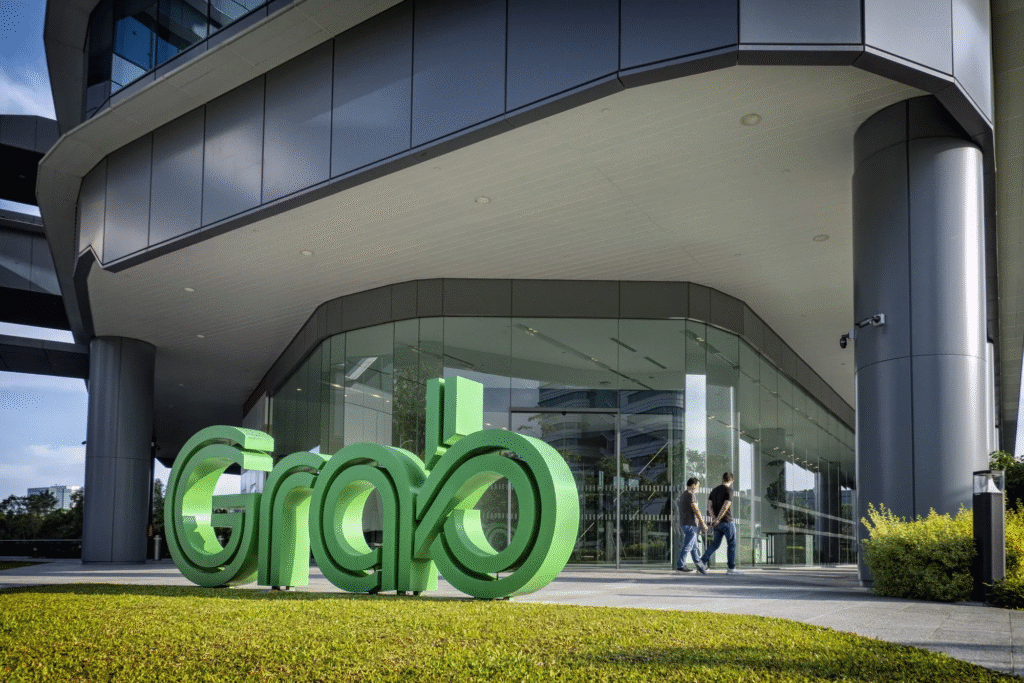Grab Holdings is a leading Southeast Asian technology company that operates a super app offering ride-hailing, food delivery, digital payments, and financial services across eight countries. Headquartered in Singapore, Grab began as a ride-hailing startup and has expanded into a multi-service platform. It now touches millions of consumers daily through services like GrabFood, GrabMart, and GrabPay. Grab aims to be the region’s everyday “super app,” similar to China’s Meituan or India’s Paytm. The company went public via SPAC merger with Altimeter Growth Corp in December 2021.

Most Recent Earnings (Q1 2025, Reported May 15, 2025)
Momentum in Deliveries, Fintech Showing Progress
- EPS: $0.02 vs expected $0.01
- Revenue: $653 million (+18% YoY) vs expected $641 million
- Adjusted EBITDA: $62 million (tripled YoY)
- Guidance: FY 2025 revenue projected at $2.6–2.7 billion (16–20% YoY growth), reaffirming profitability target for FY 2025.
Grab beat both revenue and EPS expectations in Q1, driven by strength in deliveries and ongoing improvements in mobility demand and fintech monetization. Management reiterated full-year profitability guidance, highlighting cost discipline and better unit economics.
Founding, Founders, Products, and Key Rivals
From Ride-Hailing Startup to Digital Conglomerate
Grab was founded in 2012 by Anthony Tan and Tan Hooi Ling as “MyTeksi” in Malaysia, initially focusing on taxi booking via app. The startup quickly expanded regionally, rebranding as Grab and relocating headquarters to Singapore.
Over the years, Grab diversified from transportation into food delivery (GrabFood), parcel delivery, grocery (GrabMart), and digital financial services (GrabPay, GrabFin). Its biggest strategic move was merging with Uber Southeast Asia in 2018, where Uber took a stake in Grab in exchange for ceasing regional operations.
Grab’s primary competitors include Gojek (merged with Tokopedia into GoTo Group) in Indonesia, Foodpanda in certain markets, and increasingly, local banks and fintech firms competing with GrabFin.
Grab is backed by major investors like SoftBank Vision Fund, Mitsubishi UFJ, and Uber, which still holds equity post-merger.
Market Opportunity and Growth Outlook
Digital Economy Tailwinds in Southeast Asia
Grab operates in a region with over 660 million people, rising smartphone penetration, and a growing middle class. According to Google/Temasek’s e-Conomy SEA report, the Southeast Asian digital economy is expected to exceed $360 billion by 2030, up from ~$220 billion in 2023, growing at a ~11% CAGR.
Grab’s core verticals — ride-hailing, food delivery, and financial services — are all poised for expansion. Urbanization, rising disposable income, and a preference for mobile-first services provide structural growth. Fintech, particularly digital lending and mobile payments, is one of the highest-growth categories, and GrabFin is positioning to benefit from this.
Competitor Landscape
Gojek, GoTo, and Localized Players
Grab’s main regional rival is GoTo Group, the merged entity of Gojek and Tokopedia, offering similar services including ride-hailing, delivery, and fintech across Indonesia.
In food delivery, Foodpanda (Delivery Hero) competes in several markets, especially Singapore and Thailand. In fintech, Grab competes with SeaMoney (Sea Ltd) and Bank Jago, particularly in lending and e-wallets. While Grab operates across the region, many of its rivals are stronger in specific geographies (e.g., GoTo in Indonesia).
Unique Differentiation
Hyperlocal Super App with Ecosystem Depth
What sets Grab apart is its deep integration of services into a single super app, tailored for Southeast Asian consumer behavior. While others offer standalone services, Grab combines transportation, food, grocery, logistics, and financial services with seamless UI, loyalty rewards, and personalized offers. Its merchant ecosystem and driver-partner network are also more developed than most regional competitors.
Grab is also pushing into digital banking in partnership with Singtel through their GXS Bank, giving it a first-mover advantage in neobanking for underbanked populations in Southeast Asia.
Management Team Overview
Led by Founders with Long-Term Vision
- Anthony Tan – Co-Founder and CEO. Harvard MBA, formerly from Tan Chong Motor. He’s been CEO since founding, with a strong product and operational focus.
- Peter Oey – CFO. Previously CFO at LegalZoom and CFO at MyLife.com. Brings strong IPO and cost-discipline experience.
- Tan Hooi Ling – Co-Founder. Though she stepped down from an operating role in 2023, she was instrumental in early growth and product culture.
The management team combines local insight with global experience, which has been critical for regional execution.
Financial Performance (Last 5 Years)
From Heavy Losses to Near-Term Profitability
Over the last 5 years, Grab has transitioned from a high-growth, high-burn model to more disciplined execution. Revenue grew from $1.2 billion in 2020 to $2.3 billion in 2024, at a compound annual growth rate (CAGR) of ~17%. Much of the growth has come from food delivery and fintech monetization.
Adjusted EBITDA remained negative until 2023, but losses narrowed steadily. In FY 2024, Grab posted its first adjusted EBITDA-positive year at $136 million, signaling strong cost discipline and better ride-hailing margins.
Net losses have improved from over $3.5 billion in 2020 to just under $500 million in 2024, with the company on track for potential net profitability in 2025.
Balance sheet-wise, Grab had over $5 billion in liquidity at the end of FY24, giving it sufficient runway. It has also reduced its cash burn rate significantly, particularly in deliveries and incentives.
Bull Case for GRAB
- Super App Moat: First-mover and ecosystem depth across transportation, delivery, and fintech.
- Profitability Inflection: Already EBITDA-positive with improving margins.
- Digital Banking Upside: Early lead in neobanking with GXS Bank offers future high-margin expansion.
Bear Case for GRAB
- Intense Regional Competition: Especially in Indonesia with GoTo and in fintech with SeaMoney.
- Execution Risks: Fintech monetization and regulatory hurdles could stall momentum.
- Macroeconomic Sensitivity: Southeast Asia’s economies are vulnerable to external shocks and currency volatility.

The stock is in a stage 1 consolidation within the range of $3.3 and $5.5 and should stay there for the medium term (3-6 months). The earnings outlook does not change the picture at all.